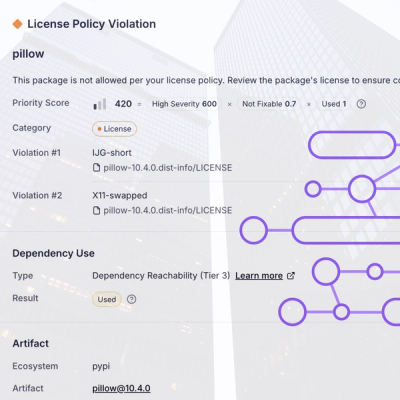
Research
/Security News
Critical Vulnerability in NestJS Devtools: Localhost RCE via Sandbox Escape
A flawed sandbox in @nestjs/devtools-integration lets attackers run code on your machine via CSRF, leading to full Remote Code Execution (RCE).
Kiyoi is a Python image viewer based on Pyside6 (Qt) and Pillow designed to easily display images with optimal use of screen real-estate. There is no superfluous UI wasting space or unnecessary features like image editing, only functionality necessary to optimally view images.
pip install kiyoi_image_viewer.run kiyoi_winreg_install at the Window console (cmd) (or python -m "kiyoi_winreg_install"). You will be prompted for admin permissions.
kiyoi_winreg_uninstall at the Window console (or python -m "kiyoi_winreg_uninstall").If your distro allows you to install Python packages directly with pip:
pip install kiyoi_image_viewer.kiyoi.desktop file (either out of the kiyoi_image_viewer site-packages folder in Python or more easily, download it from this repo)desktop-file-install /PATH/TO/kiyoi.desktop (using the real path to wherever that file is)You may be able to use the above procedure with the --user flag to pip, pip --user install kiyoi_image_viewer. This does not currently work on Arch.
For Arch and other systems that can use AUR PKGBUILD, use the PKGBUILD in the git/sourceforge repo. You only need to download that one file; it will pull the Pypi package itself.
pacman -S python-installer python-wheelmakepkgpacman -U packagenamehere run as root.kiyoi_image_viewer on the console or via the start menu.update-desktop-database.For other systems, currently I can only advise to consult your distribution's documentation on how to install unsupported python scripts. You may be able to use a virtual environment, but you will need to modify the .desktop file before installing it.
Kiyoi does not appear in the start/launch menu because it is not intended to be opened without a file. To use Kiyoi, you'll have to change file associations to point to it. If you need to invoke it directly, you can use kiyoi_image_viewer, which will immediately ask for a file.
If any of these solutions fail, let me know.
This is because more than one master instance of Kiyoi is running. The way Kiyoi works is that one master instance responds to requests for images from newly opened instances. If somehow more than one of these is running, each one will open a window, leading to duplicates.
To fix this, close all Kiyoi windows. If that fails, kill all Kiyoi processes.
This seems to be a problem with Plasma/KDE (on Linux/BSD) and also affects other programs when using that system UI. To fix it, open KDE/Plasma's System Settings and go to Window Management -> Desktop Effects, and under the "Appearance" heading, disable Morphic Popups, then apply. You will have to restart the affected program(s) and possibly your computer.
There are two possible causes for this. The most likely is that the image is simply large. Kiyoi has to open the image and then reprocess it before displaying it, so a very large image will take time to load. Alternatively, if changing image for the first time (next/previous image) is slow, the listing and sorting of files in that directory may be the problem, likely caused by an excessive number of files in the directory. Either of these can be caused by a slow drive and don't really have a solution beyond using a faster drive.
Either open an issue or send me an email at williamkappler@gmail.com with any bug reports (not already mentioned above) or suggestions. Please be aware this is a new project and the first time I've released an end-user application, so there may be some rough spots.
Other than English, all existing translations are based on Google/Bing Translate or my minimal knowledge of the given language. If you would like to improve a translation or contribute a new one, please let me know.
Kiyoi uses a simple system of string replacement for translation. locales/lang.template contains the strings to be translated for a given language. Languages should be named with single or double part language codes, such as en.lang or en_US.lang. These should use valid ISO 639-1 codes for the language if they exist. Dialect language files will be preferred if they exist and match the user's locale. For instance, if en.lang and en_US.lang exist, US users will get en_US.lang while UK users will get en.lang.
Language synonyms also map dialects to other similar dialects, should it be useful to be more specific than falling back to the root language code. For instance, en_JP is a synonym of en_US, so Japanese English users will receive US English instead of the otherwise-chosen en (UK English).
FAQs
Kiyoi Image Viewer
We found that kiyoi-image-viewer demonstrated a healthy version release cadence and project activity because the last version was released less than a year ago. It has 1 open source maintainer collaborating on the project.
Did you know?

Socket for GitHub automatically highlights issues in each pull request and monitors the health of all your open source dependencies. Discover the contents of your packages and block harmful activity before you install or update your dependencies.

Research
/Security News
A flawed sandbox in @nestjs/devtools-integration lets attackers run code on your machine via CSRF, leading to full Remote Code Execution (RCE).

Product
Customize license detection with Socket’s new license overlays: gain control, reduce noise, and handle edge cases with precision.

Product
Socket now supports Rust and Cargo, offering package search for all users and experimental SBOM generation for enterprise projects.